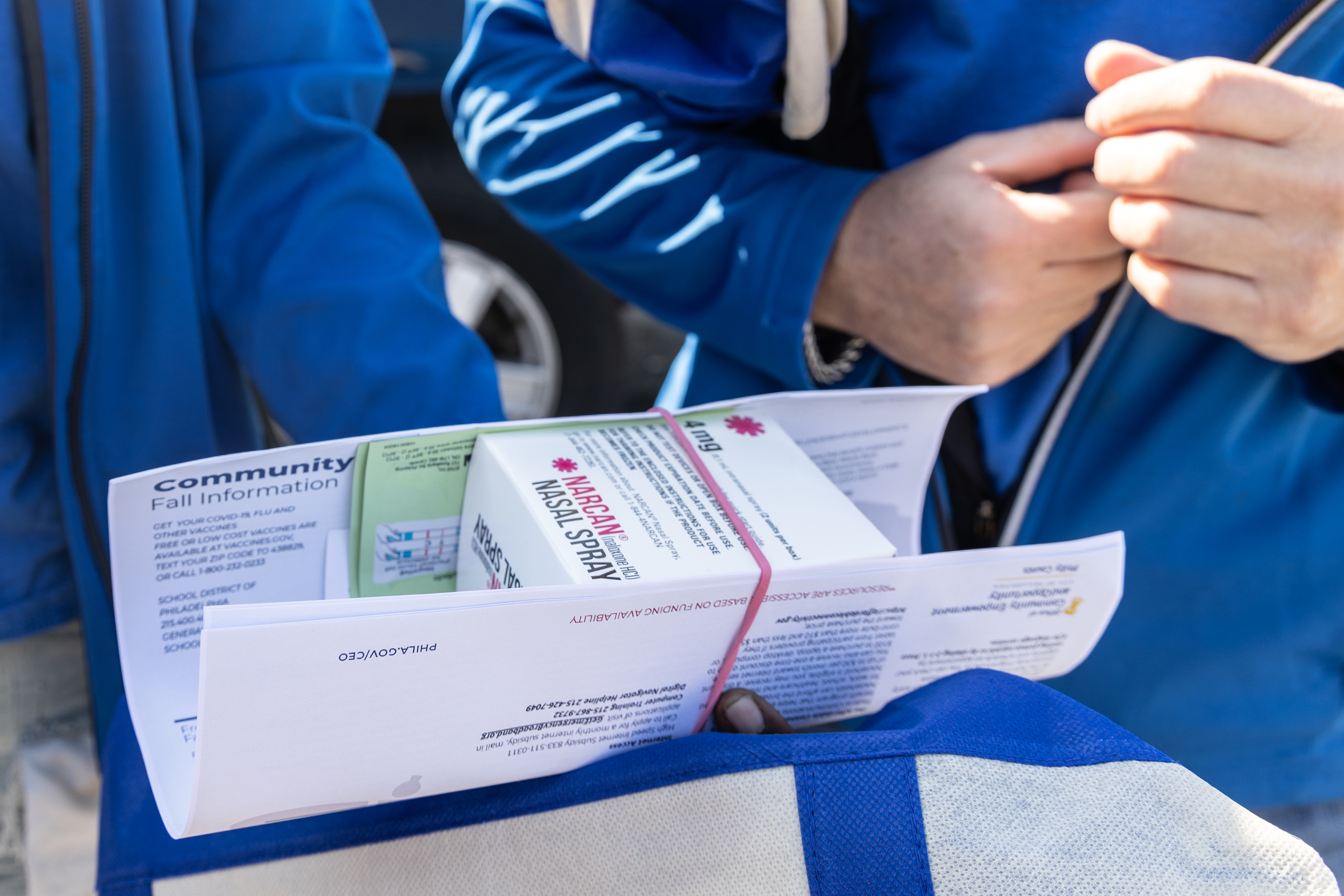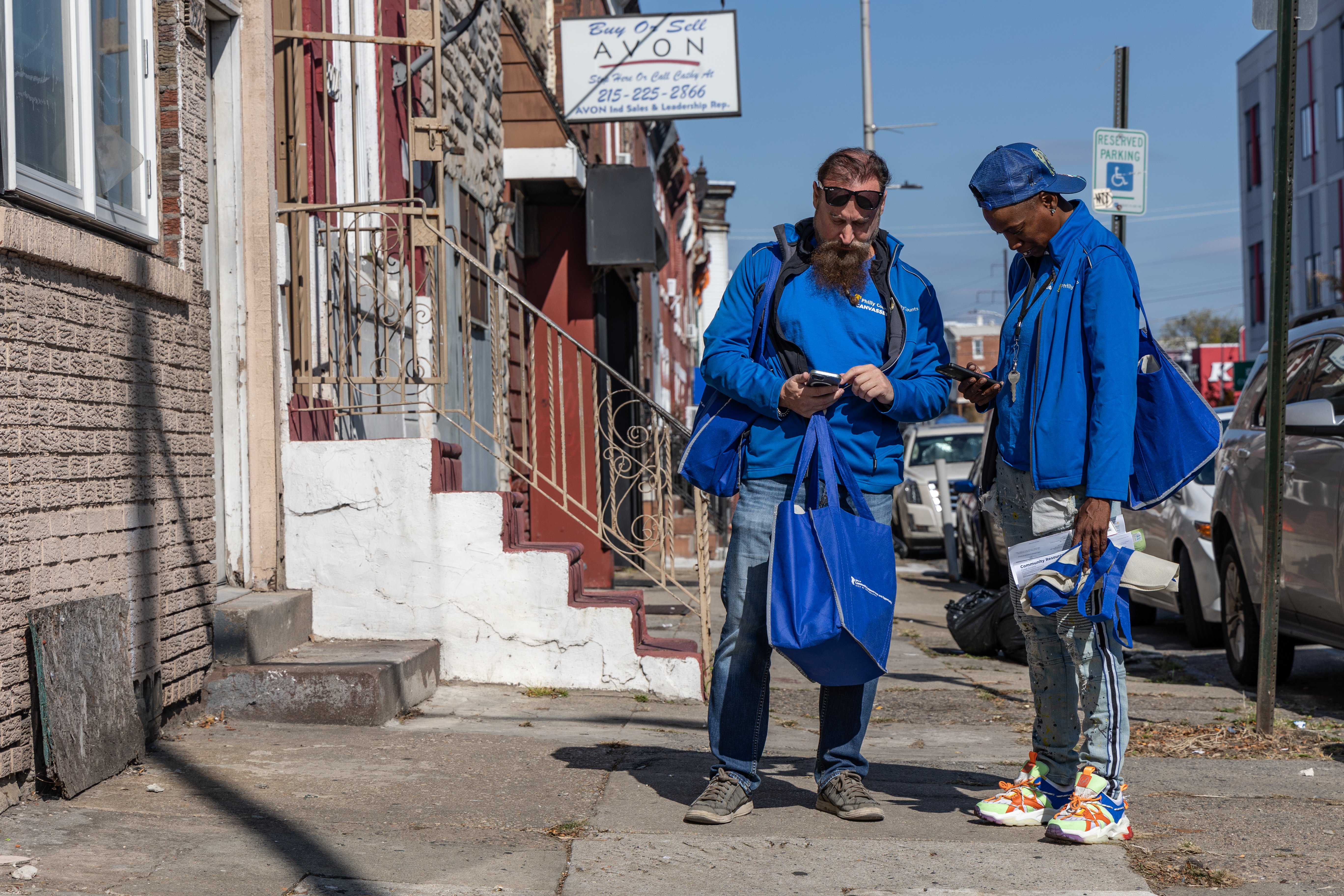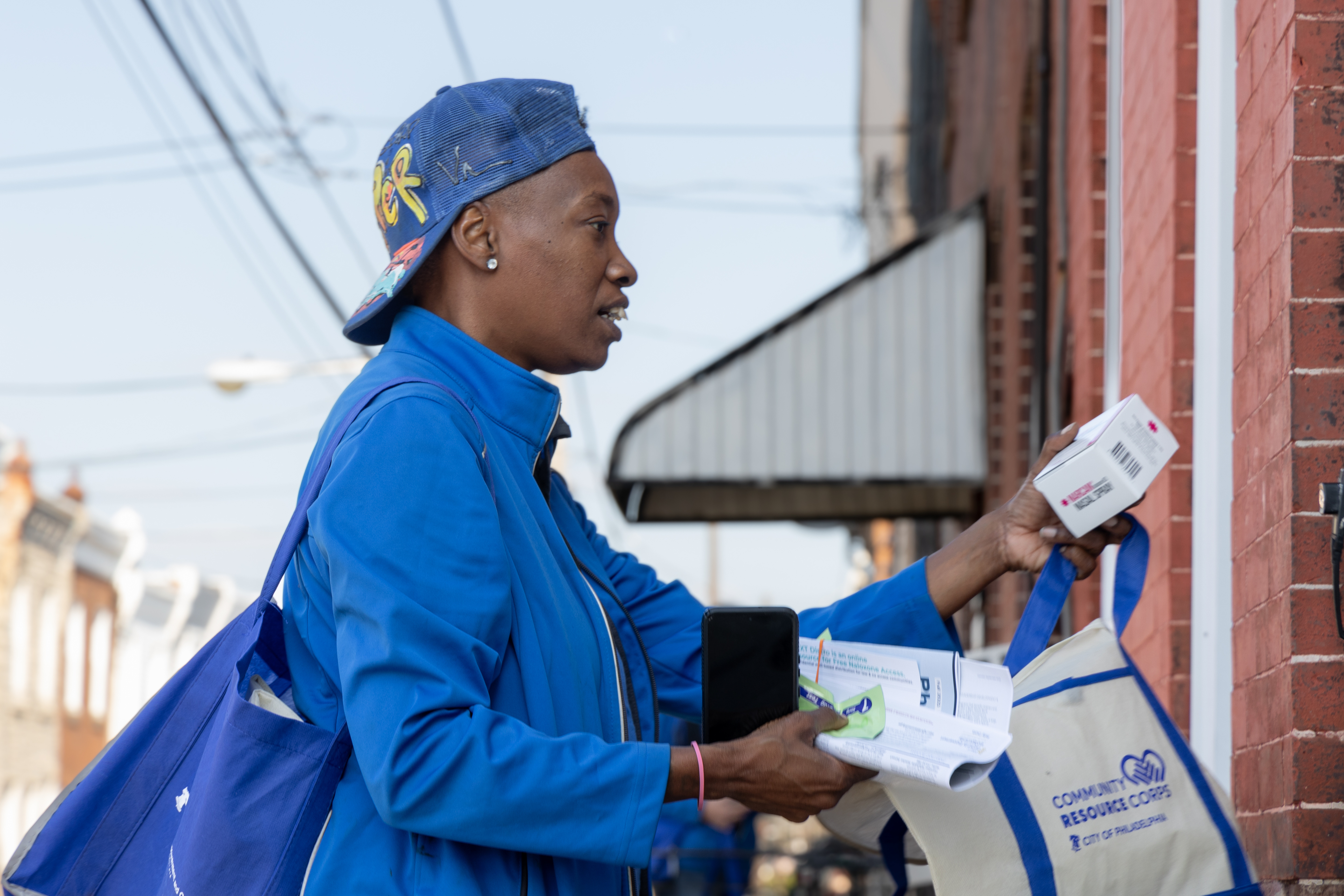On a narrow street lined with row houses and an auto body shop in the Kensington neighborhood of North Philadelphia, Marsella Elie climbs a home’s front steps and knocks hard on the door.
A middle-aged man appears with a wary look on his face.
“Hello, sir, how are you doing today?” asked Elie, wearing a royal-blue jacket embroidered with the city government’s Liberty Bell logo. “My name is Marsella. I’m working with the city. You heard about the overdoses that are going around in the neighborhood, right?”
The man gives a cautious nod.
Elie gestures to the pamphlets she’s holding about drug overdoses and addiction treatment programs. She holds up a box of Narcan, a brand of naloxone, which can reverse an opioid overdose.
“What we’re trying to do is get this in everybody’s household. Have you ever heard of this before?” Elie asked before handing the man a tote bag filled with more pamphlets, fentanyl test strips, and the box of Narcan.
Elie and other part-time city workers and volunteers are part of a large-scale, citywide door-to-door campaign in Philadelphia that aims to equip homes with naloxone and other drug overdose prevention supplies.
City officials hope that this proactive approach will normalize naloxone as an everyday item in the medicine cabinet, and prevent people from dying of overdoses, especially Black residents.
In Philadelphia in 2022, a record 1,413 people died from drug overdoses, according to city data. Among Black residents, deaths were up 20% from the year before, with many happening in private homes.
“The best thing we can do to make these things more accessible is to just give them to people,” said Keli McLoyd, deputy director of the city’s Opioid Response Unit, speaking about the tote bag with naloxone and other supplies. “We’re not asking you if you’re using drugs. The goal here is really to build sort of a collective responsibility. As Black and brown folks, as we saw during the covid epidemic, nobody’s coming to save us. For us, this is a tool that we can use to save ourselves.”

The canvassing initiative aims to take prevention supplies directly to people who might not otherwise seek it out themselves, and to spread awareness about overdoses beyond Kensington, the epicenter of the city’s addiction epidemic. Canvassers plan to knock on more than 100,000 doors in Philadelphia’s “hot spots” — ZIP codes with escalating rates of opioid overdoses, many in minority communities.
Widening racial disparities in overdose deaths are among the long-term consequences of the war on drugs, McLoyd said. Policies from that national anti-drug campaign led to decades of aggressive police tactics, racial profiling, and lengthy prison sentences, disproportionately affecting people of color and their communities.
Research shows that Black Americans still account for a disproportionate number of drug arrests and child protective services.
“Because of that, it’s very clear why Black or brown people might be hesitant to raise their hand and say, ‘I’m a person who uses drugs, I need those resources,’” McLoyd said.
Other communities have distributed naloxone and other supplies, albeit on a smaller scale than Philadelphia.
What Philadelphia is doing could become a model for other densely populated places, said Daliah Heller, vice president of drug use initiatives at Vital Strategies, a public health organization working with local governments in seven states to address the opioid epidemic.
“There’s something intensely personal about a human engagement,” Heller said. “And somebody knocking at your door to talk about drug use and overdose risk and that there’s something that can be done, I think is really powerful.”

Over the years, naloxone has become more accessible than ever before, Heller pointed out. It can now be ordered online and through the mail, it’s available in specialized vending machines, and some drugstores now sell Narcan nasal spray over the counter.
But tens of thousands of Americans are still dying from opioid overdoses every year. That means prevention efforts and messaging about the crisis are still not reaching some people, Heller said. And to her, reaching people means meeting them where they are. “That means physically, that means in terms of what they know about something, what their perception is of something, and their beliefs,” she said. “We need to think like that when we think about naloxone distribution.”
The Philadelphia canvassing project is funded in part by the city’s share of settlement payouts from national lawsuits against opioid manufacturers and distributors. The city is set to receive about $200 million over roughly 18 years from settlements with AmerisourceBergen, Cardinal Health, McKesson, and Johnson & Johnson.
The initiative is staffed by many of the same people who initially started canvassing as part of the 2020 census count.
Not everyone answers the door for the canvassers. Some aren’t home when they come around. In those cases, workers hang a flyer on the door handle that offers information about overdose risks and contacts for further resources. The teams of canvassers, often with language interpreters, later make a second sweep through a neighborhood to reach people they missed the first time.

On a recent Thursday, Philadelphia canvassers were knocking on doors in the Franklinville and Hunting Park neighborhoods. In this ZIP code, about 85 people died of drug overdoses in 2022, according to city data. That’s fewer than the 193 people who died of overdoses in Kensington in 2022, but much higher than the few deaths seen in the city’s most affluent neighborhoods.
The canvassers approached a resident, Katherine Camacho, on the sidewalk, as she came out of her garage. Camacho told the teams she was aware of the overdose problem in her community and then eagerly accepted a box of Narcan.
“I will carry this with me, because, like I said, sometimes you’re in the street driving somewhere and you could save a life,” Camacho told them. “And if you don’t have these things, it’s harder to do so, right?”
Camacho said she’s seen how the opioid crisis has caused suffering in her neighborhood and across the city. As for Philadelphia’s canvassing effort, she said she believes that “God is putting these people to help.”
As she headed into her house carrying the box of Narcan, Camacho said she wanted to do her part to help, too.







